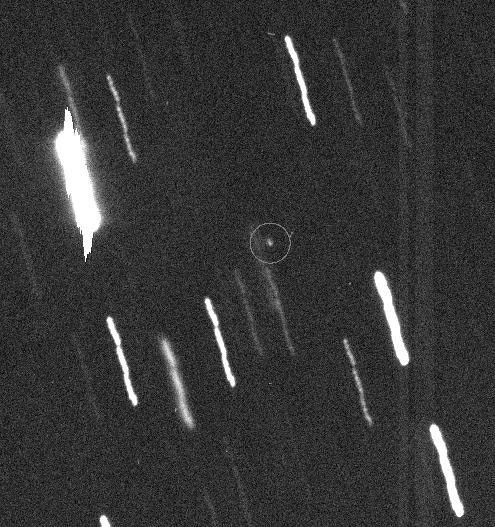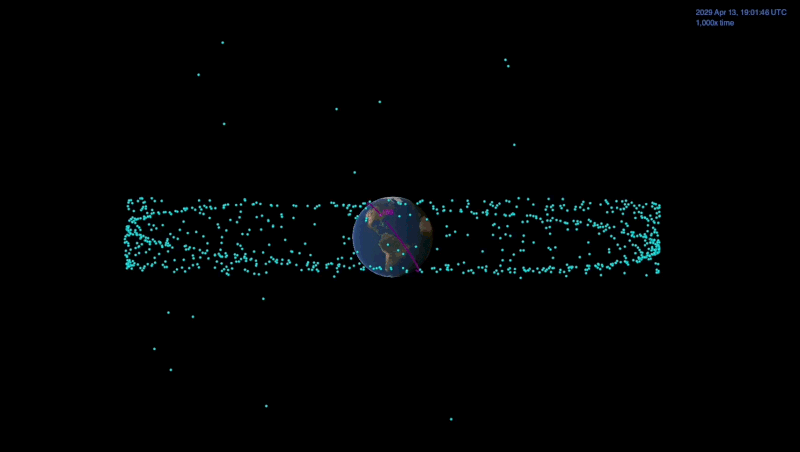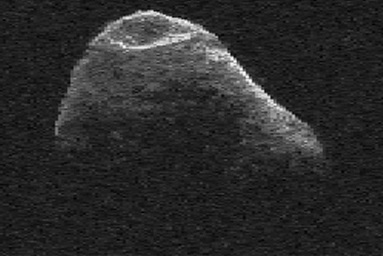

Orbit of asteroid Apophis (pink) in contrast to the orbit of Earth (blue). The yellow dot represents the sun. Apophis takes 323.6 days to orbit the sun. Earth takes 365.3 days. Image via Phoenix7777/ Wikimedia Commons.
Astronomers at the University of Hawaii issued a statement on October 26, 2020, revealing critical new findings linked to the large near-Earth asteroid 99942 Apophis, which is expected to pass close to Earth in 2029, 2036 and again in 2068. Dave Tholen and collaborators announced they have now detected a Yarkovsky acceleration on asteroid Apophis, arising from a minuscule push imparted by sunlight. This force is particularly important for asteroid Apophis, the scientists in Hawaii said, because it relates to the possibility of an Earth impact in 2068.
Tholen and colleagues used the 323-inch (8.2-meter) Subaru Telescope at Mauna Kea, Hawaii, to make the new observations. Their work suggests that the huge space rock – whose estimated diameter is between 1,115 to 1,214 feet (340 to 370 meters) – is drifting more than 500 feet (about 170 meters) per year from its expected position in its orbit.
The team will present their research later this week at a virtual conference held under the auspices of the Lunar and Planetary Institute in Houston, Texas. Referring to the encounter in 2029, the conference is called Apophis T-9 Years.
Tholen – who has been tracking the motion of Apophis in the sky since he and his colleagues discovered it from Kitt Peak National Observatory near Tucson, Arizona in on June 19, 2004 – commented:
We have known for some time that an impact with Earth is not possible during the 2029 close approach.
The new observations we obtained with the Subaru telescope earlier this year were good enough to reveal the Yarkovsky acceleration of Apophis, and they show that the asteroid is drifting away from a purely gravitational orbit by about 170 meters [about 500 feet] per year, which is enough to keep the 2068 impact scenario in play.
These observations aren’t easy to obtain and analyze, by the way. Factors such as the asteroid’s distance at the time of observation, its composition, its shape and its surface features all affect the outcome.
But astronomers are pushing to understand the orbit of asteroid Apophis because of its close sweeps past our planet in this century and beyond.
Read more about the Yarkovsky effect: Pushing asteroids around with sunlight

Because of the distance, asteroid 99942 Apophis a appears as a small dot in this telescope image. Image via University of Hawaii.
In recent years, astronomers have been able to find and track tiny asteroids sweeping very near the Earth. For example, on September 24, 2020, asteroid 2020 SW swept even closer to us than our meteorological and television satellites, and other geostationary satellites, which orbit our planet at some 22,300 miles (35,900 km) from Earth’s surface. Asteroid 2020 SW came within about 7% of the Earth-moon distance. But asteroid 2020 SW is estimated to be only about 14 to 32 feet (about 4.5 to 10 meters) in diameter. That’s very small in contrast to asteroid Apophis.
Asteroid Apophis will have an extremely close encounter with Earth on April 13, 2029. At its closest in 2029, Apophis will sweep just 23,441 miles (37,725 km) from our planet, or about 10% of the Earth-moon distance. That’s very close for a space rock over 1,115 ft (340 meters) across! Lance Benner of NASA/JPL commented:
This will be the closest approach by something this large currently known. (In 2029) Apophis will be visible to the unaided eye for several hours, and Earth tides will probably change its spin state.

This animation shows the distance between the Apophis asteroid and Earth at the time of the asteroid’s closest approach in 2029. The blue dots are manmade satellites orbiting our planet, and the pink represents the International Space Station. Image via NASA/JPL-Caltech.
Although the probability of an impact from asteroid Apophis for 2029 and 2036 has been ruled out, the new findings suggest that there might be a very small chance of impact in April 2068. Previous calculations made in 2016 had all but ruled out the probability of an impact on 2068. The chance of an impact was seen in 2016 as vanishingly small, at just 1 in 150,000 odds of impact, or a 99.99933% chance the asteroid would miss the Earth. The new findings might slightly change these numbers again, as new calculations are made, using both the recent data and new observations that will be made very soon.
Astronomers will know well before 2068 if there is any chance of an impact from Apophis. And opportunities for observing asteroid Apophis are coming up again soon.

Another radar image of asteroid 99942 Apophis. Image via NASA/ JPL.
This year, and next (December 2020 and April 2021) astronomers are planning to study asteroid Apophis using NASA’s NEOWISE infrared space telescope. This is the same telescope that discovered 2020’s favorite comet, Comet NEOWISE, which has now faded from view.
Due to its short orbital period around the sun of only 323.6 days (less than an Earth year), asteroid Apophis comes by this region of the solar system quite often and will have a distant encounter with Earth in just a few months. On the night of March 5, 2021, the huge space rock will pass at 10,471,577 miles (16,852,369 km) from our planet, i.e. about 44 times the distance to the moon. Apophis is then expected to reach a visual magnitude of 15 to 16, too faint to be seen in small telescopes, but within the reach of 12-inch-diameter and larger telescopes, and possibly even smaller telescopes using sensitive cameras.
Astronomers will also study Apophis during the 2021 flyby with radar observations, using the Goldstone observatory in California. If the Arecibo observatory is sufficiently repaired by that time, studies of Apophis from there would be significant as the radio telescope in Puerto Rico would provide more detailed detections of this asteroid.
These observations of Apophis should improve our knowledge of its shape and spin state, and they’ll help reduce uncertainties in the space rock’s orbit caused by Yarkovsky acceleration.
This 2021 flyby will be Apophis’ closest approach until the great encounter in 2029.
Friday, April 13, 2029, will be more of a showtime for the general public and astronomers alike. Apophis will come so close that it’ll be visible to the unaided eye alone; something that almost never happens with asteroids! According to NASA, Apophis will first become visible in the Southern Hemisphere and will look like a speck of light moving across Australia during this close encounter. It will be over the Atlantic Ocean at its closest approach to Earth. It will move so fast that it crosses the Atlantic in just an hour, and will have crossed the U.S. in the late afternoon/early evening within the next hour. Calculations indicate that Apophis will reach a visual magnitude of 3.1 during this approach, comparable to the stars in the Little Dipper. It is expected to be visible to the unaided eye from some areas of Australia, western Asia, Africa, and Europe.
Like many other asteroids, Apophis has been classified as a Potentially Hazardous Asteroid by the International Astronomical Union’s Minor Planet Center.
According to some estimates, an asteroid the size of Apophis can be expected to strike Earth about every 80,000 years.

As a result of the extremely close approach of April 2029, it is expected that perturbations caused by Earth’s gravity will change Apophis’ orbit from the Aten to the Apollo class. (NASA/JPL)
Bottom line: Asteroid Apophis is a relatively large body, noteworthy for its extremely close approaches to Earth in 2029, 2036 and 2068. Astronomers in Hawaii have now measured a Yarkovsky effect for this asteroid – a change in its orbital motion, due to a tiny push imparted by sunlight as the asteroid spins – as they strive to pin down the asteroid’s orbit with precision.
Read more about the Yarkovsky effect: Pushing asteroids around with sunlight
Source:
https://earthsky.org/space/asteroid-99942-apophis-encounters-2029-2036-2068
